Weekend Wanderlust: Pescocostanzo, Abruzzo's 'City of Art'
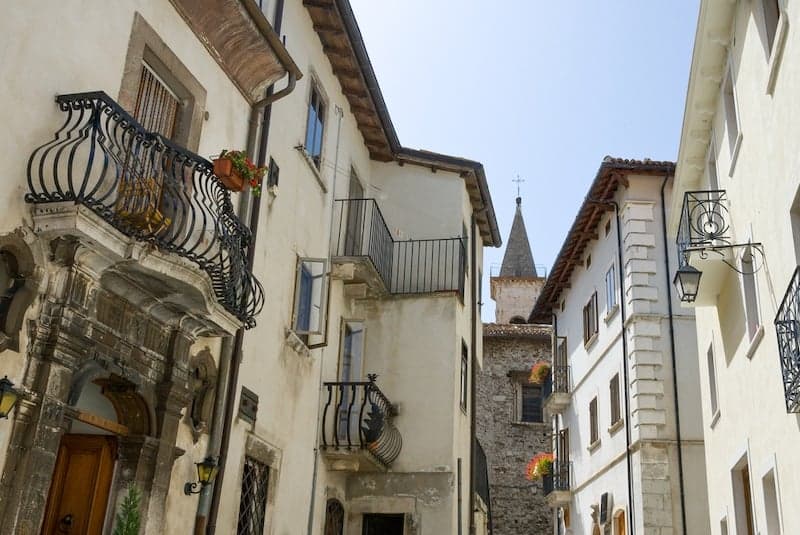
American writer Kathryn Casey, who has a home in Abruzzo, shares her guide to one of the region's loveliest highland villages.
To savour Italy unyoked from the herds that clog the narrow cobbled arteries of Rome, you might try a few days in the alpine Abruzzo region. Much neglected by tourists yet just over the border of Lazio, Abruzzo is a verdant paradise of national parks, wildlife reserves, and botanical gardens.
There’s hearty highland cooking at little spots where you just take the courses as the host brings them. The landscape is dotted with family farms where you can roll up, ring at the door, and buy a variety of portable palate pleasers like infused honeys, wine, genziana, olive oil, and the region’s ubiquitous pecorinos.
READ ALSO: 'Abruzzo's food keeps you coming back for more'
There are rock-climbing lessons, Italian maiolica and saffron tours (Abruzzo saffron is widely considered the best in the world), castles and monasteries to visit, and hosts of picturesque hill villages, each with its own attractions and claims to fame.
One of those villages is Pescocostanzo, the “City of Art" in the Aquilana highlands, about 120 miles from Rome.
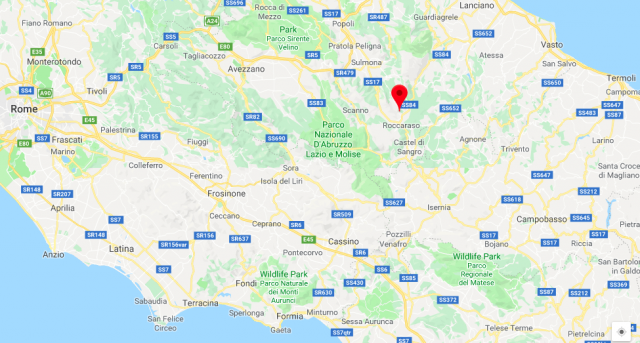
Pescocostanzo lies in the mountainous centre of Italy, in the province of L'Aquila in Abruzzo. Image: Google Maps
A living picture postcard designated one of “the most beautiful villages in Italy”, Pescocostanzo is a pleasant walking town with a lovely central square. For an overnight stay, you can check into the cozy four-star Hotel Le Torri in the pedestrian centre, then stroll among the quaint homes and shopfronts; sample locally-sourced highland fare; visit historic churches; or head out to the miles of nearby ski, hiking and horseback-riding trails. And you can do it all against a soundtrack of squabbling birds rather than screaming motorini.
READ ALSO: Are these Italy's most beautiful villages?
The town’s population numbers about 1,300, although that’s about 1,000 more than seems altogether likely. Yet Pescocostanzo’s snow-globe-sized beauty belies its cultural prominence. Its status in the Middle Ages as a Universitas Sui Domina (self-governing community) and as a commercial centre for wool bound for Lombardia and Tuscany made the region not only wealthy but a rich crossroads in which the arts thrived. (Interestingly, the word for money in the local dialect is pecunia, from pecora – sheep.)
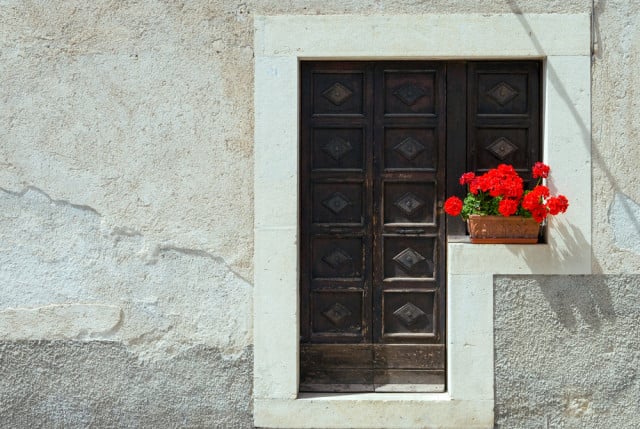
Carved doors in Pescocostanzo. Photo: DepositPhotos
Among those arts was stone- and wood-cutting – readily visible in the facades of Renaissance homes and in the interiors of the town’s churches. In fact, the typically Renaissance urban architecture was to a great extent the product of architects and master masons summoned from Florence and Como. Even Michelangelo exerted his influence on the character of the city.
That, together with the many art exhibitions it hosts, is part of the reason Pescocostanzo can claim its artistic moniker. It’s an indoor/outdoor museum of Renaissance art and architecture, and of ancient artisanal crafts like wrought iron, lace work and goldsmithery.
Pescocostanzo’s entrance promenade looks like a backgammon board made of chocolate and vanilla brick. It’s a visual metaphor for a leisurely day making whatever moves you choose. On my last visit, I parked just outside the town’s pedestrian centre and followed the inviting game board into the city’s heart, toward the central square with its picture-perfect clock tower set against the peaks of the Majella mountains.
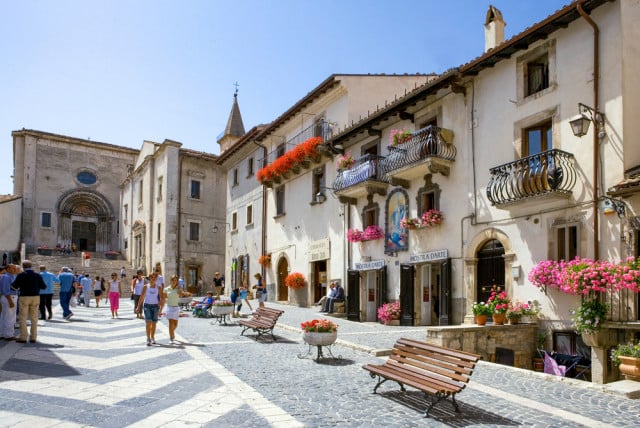
The pedestrian centre of Pescocostanzo. Photo: DepositPhotos
I was there primarily on a shopping mission, but I ducked into the 11th-century Basilica di Santa Maria del Colle for a few minutes. I soaked in the magnificent altarpieces of colourful inlaid marble and the carved and gilded wooden ceiling before moving on to the real reason for my visit: the crucifix.
In this unpretentious parish church is, I believe, the most memorable crucifix I’ve seen. Of carved and painted wood, it depicts with rawness and immediacy a tormented Christ whose skin is torn and who is crying in agony. (A priest alongside me remarked that this image was not dissimilar to that depicted in the film The Passion of the Christ. I had to agree.)
Pescocostanzo’s shops are relatively few, but worth the trouble. Artisans today still practice trades handed down to them from the Middle Ages. The quality of goods like decorative wrought iron, gold filigree and lace is unmistakable; you can buy off-the-rack, so to speak, or commission truly distinctive traditional pieces.
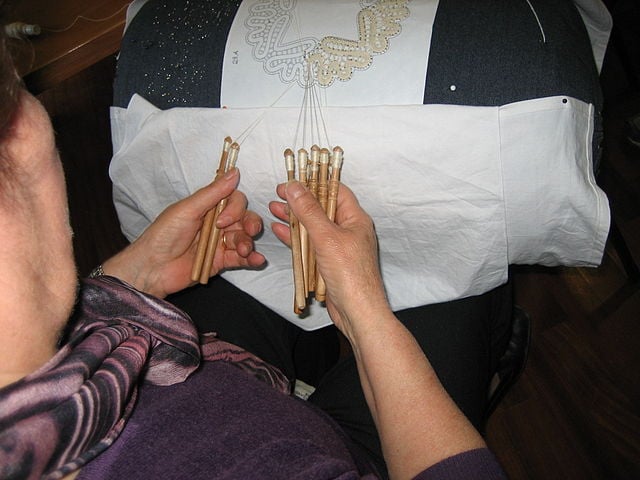
Traditional lace weaving in Pescocostanzo. Photo: io via Wikimedia
I’m not a huge fan of lace, but the Scuola di merletto a tombolo (School of Bobbin Lace) is a real find for anyone who is. It serves triple duty as school, museum and shop. On display are intricate lace and embroidery in centuries-old motifs and ancient instruments of seasoned olive and pear wood on which artisans – many of them girls engaged to be married who were creating their own trousseaus – once worked their pillow designs.
The technique is called fuselli su tombolo, the tombolo being a cylinder of wood from which little wooden rods, or fuselli, each connected to a thread, guide the lace. The trade, and the Scuola, are enjoying a renaissance among young people who hope to make a living while remaining in the village of their birth.
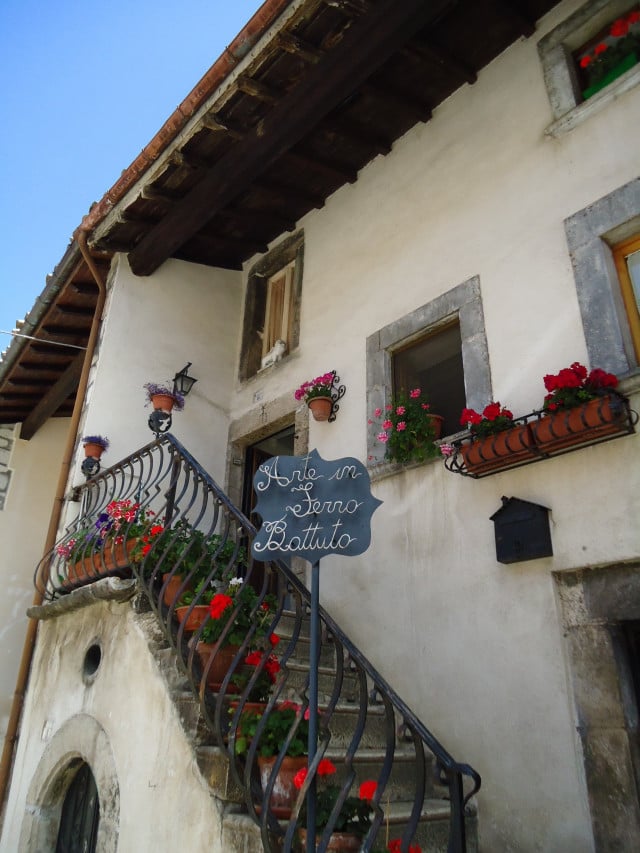
Ferro battuto, or wrought iron, is another of Pescocostanzo's specialities. Photo: Kathryn Casey
I am a fan of wrought iron, and had come back to buy a pair of sconces I’d been eyeballing for awhile at a garage-like shop called Nicolò. Once inside, I spotted an iron headboard in a geometric design and toyed with the idea of taking that, too, until I remembered that I had no way to transport it.
Inside a jewel-box shop called Trine d’Oro, I watched goldsmith Roberto Colamarino as he bent over his work reinterpreting some of the region’s classics. He does so to dazzling effect, introducing tiny rubies, sapphires, and emeralds into delicate pieces of gold or gold thread. Colamarino speaks rapid-fire Italian, so you really have to be up for the experience: unless you’re quite adept, you should probably be prepared to point and buy, or trot out some eloquent charades moves.
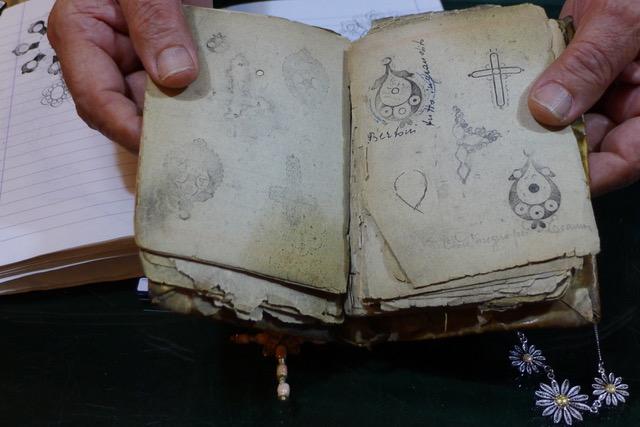
Goldsmith Antonio Domenicano's notebook of designs. Photo: Kathryn Casey
A matter of steps from Colamarino’s shop is Antonio Domenicano's Oreficeria. Ten or so years ago, the eponymous goldsmith had shown me a timeworn notebook of designs crafted by his grandfather in the early 1900s. After perusing the printed loot, I’d settled on a ring in a butterfly filigree, which he custom-made in my size. (The ring, which cost about $300 at the time, has bedazzled friends and strangers alike and left even snooty Bergdorf’s clerks agog.) I asked to see the book again.
The downside to custom orders from Domenicano is that you need to arrange for pick-up when they’re ready, and it won’t be tomorrow. This time, I simply added a gold and emerald bead to a traditional necklace I’d bought several years before. Typically, one’s husband adds beads through the years to mark his growing love; I didn’t have a husband to do that, so self-indulgence had to pass.
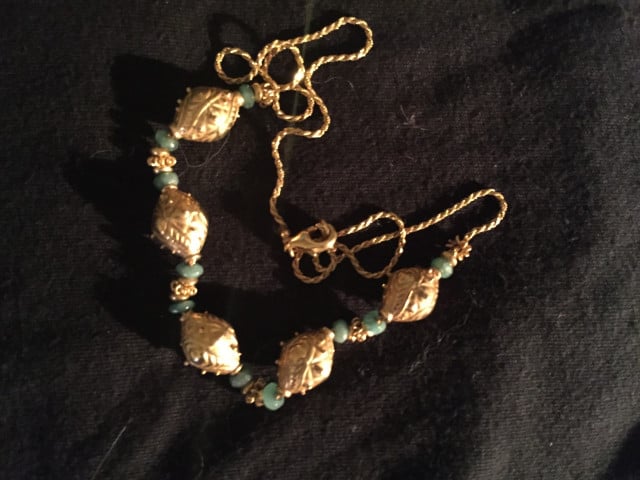
Traditional gold jewellery from Pescocostanzo. Photo: Kathryn Casey
In winter, “Pesco” has a diamond hardness, sparkling, cold, and edgy, its approach along mountain roads sometimes forbidding. Its situation 1,400 metres above sea level at the hemline of the Bosco di Sant’Antonio, part of the Majella National Park, makes it popular with Italian skiers.
On the way in or out of town, you can stop in the Bosco di Sant’Antonio (ten miles of protected forest) for a picnic and a hike or, if the equestrian spirit moves you, hire horses to carry you through the ancient beech woods. (But beware! You might take it into your head to climb a gnarled tree and have a tough time getting down again. I had reason once to offer a prayer of thanks to the sylvan gods that nobody was around to witness my shame.)
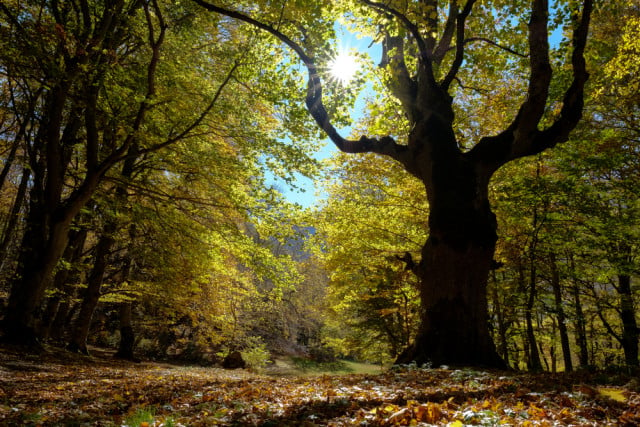
The Bosco di Sant'Antonio is thought to be among the oldest woodland in Italy. Photo: DepositPhotos
Pescocostanzo is one of my favourite highland towns in Abruzzo. I often recommend it as an easy getaway from the eternal roar of Rome.
Kathryn Casey is a New York-based writer with a home in Abruzzo who – she says – is almost criminally incompetent to own a home anywhere. This is an edited version of an article originally published on her blog, Part-time Italian.
Would you like to write a guest post for The Local? If so, please email us.
Comments
See Also
To savour Italy unyoked from the herds that clog the narrow cobbled arteries of Rome, you might try a few days in the alpine Abruzzo region. Much neglected by tourists yet just over the border of Lazio, Abruzzo is a verdant paradise of national parks, wildlife reserves, and botanical gardens.
There’s hearty highland cooking at little spots where you just take the courses as the host brings them. The landscape is dotted with family farms where you can roll up, ring at the door, and buy a variety of portable palate pleasers like infused honeys, wine, genziana, olive oil, and the region’s ubiquitous pecorinos.
READ ALSO: 'Abruzzo's food keeps you coming back for more'
There are rock-climbing lessons, Italian maiolica and saffron tours (Abruzzo saffron is widely considered the best in the world), castles and monasteries to visit, and hosts of picturesque hill villages, each with its own attractions and claims to fame.
One of those villages is Pescocostanzo, the “City of Art" in the Aquilana highlands, about 120 miles from Rome.

Pescocostanzo lies in the mountainous centre of Italy, in the province of L'Aquila in Abruzzo. Image: Google Maps
A living picture postcard designated one of “the most beautiful villages in Italy”, Pescocostanzo is a pleasant walking town with a lovely central square. For an overnight stay, you can check into the cozy four-star Hotel Le Torri in the pedestrian centre, then stroll among the quaint homes and shopfronts; sample locally-sourced highland fare; visit historic churches; or head out to the miles of nearby ski, hiking and horseback-riding trails. And you can do it all against a soundtrack of squabbling birds rather than screaming motorini.
READ ALSO: Are these Italy's most beautiful villages?
The town’s population numbers about 1,300, although that’s about 1,000 more than seems altogether likely. Yet Pescocostanzo’s snow-globe-sized beauty belies its cultural prominence. Its status in the Middle Ages as a Universitas Sui Domina (self-governing community) and as a commercial centre for wool bound for Lombardia and Tuscany made the region not only wealthy but a rich crossroads in which the arts thrived. (Interestingly, the word for money in the local dialect is pecunia, from pecora – sheep.)

Carved doors in Pescocostanzo. Photo: DepositPhotos
Among those arts was stone- and wood-cutting – readily visible in the facades of Renaissance homes and in the interiors of the town’s churches. In fact, the typically Renaissance urban architecture was to a great extent the product of architects and master masons summoned from Florence and Como. Even Michelangelo exerted his influence on the character of the city.
That, together with the many art exhibitions it hosts, is part of the reason Pescocostanzo can claim its artistic moniker. It’s an indoor/outdoor museum of Renaissance art and architecture, and of ancient artisanal crafts like wrought iron, lace work and goldsmithery.
Pescocostanzo’s entrance promenade looks like a backgammon board made of chocolate and vanilla brick. It’s a visual metaphor for a leisurely day making whatever moves you choose. On my last visit, I parked just outside the town’s pedestrian centre and followed the inviting game board into the city’s heart, toward the central square with its picture-perfect clock tower set against the peaks of the Majella mountains.

The pedestrian centre of Pescocostanzo. Photo: DepositPhotos
I was there primarily on a shopping mission, but I ducked into the 11th-century Basilica di Santa Maria del Colle for a few minutes. I soaked in the magnificent altarpieces of colourful inlaid marble and the carved and gilded wooden ceiling before moving on to the real reason for my visit: the crucifix.
In this unpretentious parish church is, I believe, the most memorable crucifix I’ve seen. Of carved and painted wood, it depicts with rawness and immediacy a tormented Christ whose skin is torn and who is crying in agony. (A priest alongside me remarked that this image was not dissimilar to that depicted in the film The Passion of the Christ. I had to agree.)
Pescocostanzo’s shops are relatively few, but worth the trouble. Artisans today still practice trades handed down to them from the Middle Ages. The quality of goods like decorative wrought iron, gold filigree and lace is unmistakable; you can buy off-the-rack, so to speak, or commission truly distinctive traditional pieces.

Traditional lace weaving in Pescocostanzo. Photo: io via Wikimedia
I’m not a huge fan of lace, but the Scuola di merletto a tombolo (School of Bobbin Lace) is a real find for anyone who is. It serves triple duty as school, museum and shop. On display are intricate lace and embroidery in centuries-old motifs and ancient instruments of seasoned olive and pear wood on which artisans – many of them girls engaged to be married who were creating their own trousseaus – once worked their pillow designs.
The technique is called fuselli su tombolo, the tombolo being a cylinder of wood from which little wooden rods, or fuselli, each connected to a thread, guide the lace. The trade, and the Scuola, are enjoying a renaissance among young people who hope to make a living while remaining in the village of their birth.
Ferro battuto, or wrought iron, is another of Pescocostanzo's specialities. Photo: Kathryn Casey
I am a fan of wrought iron, and had come back to buy a pair of sconces I’d been eyeballing for awhile at a garage-like shop called Nicolò. Once inside, I spotted an iron headboard in a geometric design and toyed with the idea of taking that, too, until I remembered that I had no way to transport it.
Inside a jewel-box shop called Trine d’Oro, I watched goldsmith Roberto Colamarino as he bent over his work reinterpreting some of the region’s classics. He does so to dazzling effect, introducing tiny rubies, sapphires, and emeralds into delicate pieces of gold or gold thread. Colamarino speaks rapid-fire Italian, so you really have to be up for the experience: unless you’re quite adept, you should probably be prepared to point and buy, or trot out some eloquent charades moves.

Goldsmith Antonio Domenicano's notebook of designs. Photo: Kathryn Casey
A matter of steps from Colamarino’s shop is Antonio Domenicano's Oreficeria. Ten or so years ago, the eponymous goldsmith had shown me a timeworn notebook of designs crafted by his grandfather in the early 1900s. After perusing the printed loot, I’d settled on a ring in a butterfly filigree, which he custom-made in my size. (The ring, which cost about $300 at the time, has bedazzled friends and strangers alike and left even snooty Bergdorf’s clerks agog.) I asked to see the book again.
The downside to custom orders from Domenicano is that you need to arrange for pick-up when they’re ready, and it won’t be tomorrow. This time, I simply added a gold and emerald bead to a traditional necklace I’d bought several years before. Typically, one’s husband adds beads through the years to mark his growing love; I didn’t have a husband to do that, so self-indulgence had to pass.

Traditional gold jewellery from Pescocostanzo. Photo: Kathryn Casey
In winter, “Pesco” has a diamond hardness, sparkling, cold, and edgy, its approach along mountain roads sometimes forbidding. Its situation 1,400 metres above sea level at the hemline of the Bosco di Sant’Antonio, part of the Majella National Park, makes it popular with Italian skiers.
On the way in or out of town, you can stop in the Bosco di Sant’Antonio (ten miles of protected forest) for a picnic and a hike or, if the equestrian spirit moves you, hire horses to carry you through the ancient beech woods. (But beware! You might take it into your head to climb a gnarled tree and have a tough time getting down again. I had reason once to offer a prayer of thanks to the sylvan gods that nobody was around to witness my shame.)

The Bosco di Sant'Antonio is thought to be among the oldest woodland in Italy. Photo: DepositPhotos
Pescocostanzo is one of my favourite highland towns in Abruzzo. I often recommend it as an easy getaway from the eternal roar of Rome.
Kathryn Casey is a New York-based writer with a home in Abruzzo who – she says – is almost criminally incompetent to own a home anywhere. This is an edited version of an article originally published on her blog, Part-time Italian.
Would you like to write a guest post for The Local? If so, please email us.
Join the conversation in our comments section below. Share your own views and experience and if you have a question or suggestion for our journalists then email us at [email protected].
Please keep comments civil, constructive and on topic – and make sure to read our terms of use before getting involved.
Please log in here to leave a comment.